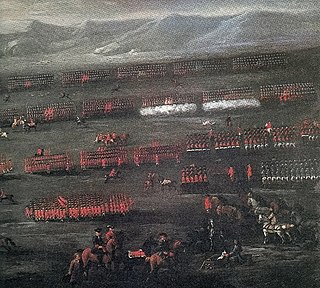Related Research Articles

Inverclyde is one of 32 council areas used for local government in Scotland. Together with the East Renfrewshire and Renfrewshire council areas, Inverclyde forms part of the historic county of Renfrewshire, which currently exists as a registration county and lieutenancy area. Inverclyde is located in the west central Lowlands. It borders the North Ayrshire and Renfrewshire council areas, and is otherwise surrounded by the Firth of Clyde.

Earl of Galloway is a title in the Peerage of Scotland. It was created in 1623 for Alexander Stewart, 1st Lord Garlies, with remainder to his heirs male bearing the name and arms of Stewart. He had already been created Lord Garlies in the Peerage of Scotland in 1607, with remainder to the heirs male of his body succeeding to the estates of Garlies. This branch of the Stewart family were distant relatives of the Stewart Kings of Scotland.

Earl of Gosford is a title in the Peerage of Ireland. It was created in 1806 for Arthur Acheson, 2nd Viscount Gosford.

The Lord Lieutenant of Renfrewshire is the representative of the British Crown covering a lieutenancy area of the county of Renfrewshire in the west central Lowlands of Scotland.
Lucinda, Lady Shaw-Stewart(b. ca. 1950?, Yorkshire) has been Trustee of the Royal Collection Trust from 2005; Vice-President of the National Trust for Scotland; Convenor of the National Trust for Scotland's Curatorial Committee; Trustee of Sir William Burrell's Trust; Trustee of the Wallace Collection from 1987.

Inverkip is a village and parish in the Inverclyde council area and historic county of Renfrewshire in the west central Lowlands of Scotland, 5 miles (8 km) southwest of Greenock and 8.1 miles (13 km) north of Largs on the A78 trunk road. The village takes its name from the River Kip and is served by Inverkip railway station.
Sir Michael Hugh Shaw-Stewart, 8th Baronet was a Scottish politician, soldier and landowner.
Three Steuart baronetcies were given to three brothers, the first, fourth, and seventh of the seven sons of Sir James Steuart, knight, Lord Provost of Edinburgh, who died in 1681.

Ardgowan Castle, originally called Inverkip Castle, is located in the Private Garden of "Ardgowan House, Castle & Gardens" near Inverkip, Scotland. It is near the Firth of Clyde in Inverclyde, in the former county of Renfrewshire. The three-storey ruin of the 15th century tower house is protected as a category B listed building.

Ardgowan House, Castle & Gardens is a Privately owned late 18th-century mansion on the Firth of Clyde near Inverkip, Scotland. Ardgowan is located in Inverclyde, in the former county of Renfrewshire. The Ardgowan Estate has been held by the Stewart family since the early 15th century: towards the end of that century, their tower house Ardgowan Castle was built within the site of the previous Inverkip Castle fortress. The present house was erected in 1797 and completed in 1801 from designs by Cairncross. It is the seat of the Shaw Stewart baronets, currently Sir Ludovic Houston Shaw Stewart, 12th Baronet of Greenock and Blackhall.
The lands of Finnart to the west of Greenock belonged to the Earl of Douglas in medieval times. Around 1455 they were forfeited to the crown. Finnart was given to the Hamiltons, while the western part of the barony of Finnart went to Stewart of Castlemilk and became the barony of Finnart-Stewart, or Gourock.

Blackhall Manor is a tower house in Paisley in Renfrewshire, in the western central Lowlands of Scotland. It dates to the sixteenth century, although parts may be older, and formerly belonged to the Stewart or Shaw-Stewart family. It was designated as a Category B listed building in 1971.
Before the Acts of Union 1707, the barons of the shire of Renfrew elected commissioners to represent them in the unicameral Parliament of Scotland and in the Convention of the Estates. The number of commissioners was increased from two to three in 1690.

Sir John Maxwell, 8th Baronet, FRSE was a Scottish landowner and politician.
Marie Lamont, also referred to as Mary Lawmont (1646–1662), was executed for witchcraft during the reign of Charles II just after Witchmania had peaked in the United Kingdom. Her youth at the time of her execution made her case unusual.
John Shaw Stewart FRSE (1793–1840) was a 19th-century Scottish advocate and essayist.

Sir John Shaw, 3rd Baronet of Greenock was a Scottish Whig politician who sat in the House of Commons between 1708 and 1734. He was instrumental in the construction of Greenock Harbour, and took part in actions against the Jacobite risings.
Sir Michael Shaw-Stewart, 6th Baronet was a Scottish politician, Member of Parliament for Lanarkshire 1827–1830 and Renfrewshire 1830–1836.

Sir Michael Shaw-Stewart, 5th Baronet. Lord Lieutenant of Renfrewshire between 1822 and 1825.

The Shaw or Schaw baronetcy, of Greenock in the County of Renfrew, was created in the Baronetage of Nova Scotia on 28 June 1687 for John Shaw, Member for Renfrewshire. The third Baronet sat as Member of Parliament for Renfrewshire and Clackmannanshire.
References
- 1 2 Mosley, Charles, ed. (2003). Burke's Peerage, Baronetage & Knighthood (107 ed.). Burke's Peerage & Gentry. pp. 3589–3591. ISBN 0-9711966-2-1.
- ↑ Bolton, J. S. (1989), From Royal Stewart to Shaw Stewart, Greenock: Orr Pollock & Co. Ltd., ISBN 978-0951460900
- ↑ Biographical Index of Former Fellows of the Royal Society of Edinburgh 1783–2002 (PDF). The Royal Society of Edinburgh. July 2006. ISBN 0-902-198-84-X.
- ↑ "Sir Houston Shaw-Stewart, Bt". The Daily Telegraph. London. 25 March 2004. Retrieved 30 May 2019.